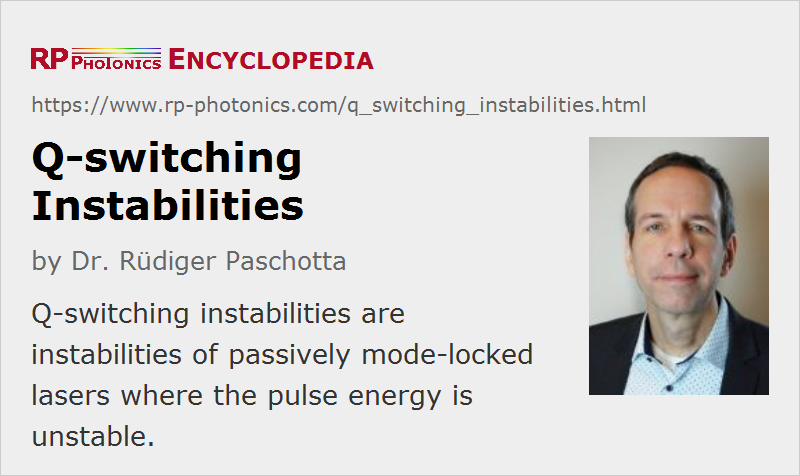Q-switching Instabilities
Definition: instabilities of passively mode-locked lasers where the pulse energy is unstable
German: Q-Switching-Instabilitäten, Instabilitäten beim Güteschalten
Categories:  fluctuations and noise,
fluctuations and noise,  light pulses
light pulses
Author: Dr. Rüdiger Paschotta
Cite the article using its DOI: https://doi.org/10.61835/piq
Get citation code: Endnote (RIS) BibTex plain textHTML
When a laser (particularly a solid-state laser) is passively mode locked with a saturable absorber, it can exhibit so-called Q-switching instabilities. In some cases, Q-switched mode locking can lead to the regular emission of bunches (burst) of pulses with fairly stable parameters, but in other cases there are substantial fluctuations of the pulse parameters. Typically, rather unstable behavior is obtained when the parameters are chosen such that the bunch period becomes long and the pulse energy can become extremely low between the pulse bunches. In that case, the pulses in each bunch are essentially generated starting from spontaneous emission, and the pulse parameters cannot reach a steady state because a bunch corresponds only to a few resonator round trips.
The article on Q-switched mode locking discusses possible measures for suppressing Q-switching instabilities, i.e., for obtaining stable continuous-wave mode locking with a constant pulse energy. In certain parameter regions, e.g. ultrahigh pulse repetition rates or high output power, this can be difficult or at least require compromises e.g. concerning the pulse duration.
Note that there are other types of instabilities of mode-locked lasers, which are not easily distinguished from Q-switching instabilities in experiments, but have a definitely different origin (e.g. a too long recovery time of the saturable absorber) and accordingly need different methods to be suppressed.
More to Learn
Encyclopedia articles:
Bibliography
| [1] | H. Haus, “Parameter ranges for CW passive mode locking”, IEEE J. Quantum Electron. 12 (3), 169 (1976); https://doi.org/10.1109/JQE.1976.1069112 |
| [2] | F. X. Kärtner et al., “Control of solid-state laser dynamics by semiconductor devices”, Opt. Eng. 34, 2024 (1995); https://doi.org/10.1117/12.204794 |
| [3] | C. Hönninger et al., “Q-switching stability limits of cw passive mode locking”, J. Opt. Soc. Am. B 16 (1), 46 (1999); https://doi.org/10.1364/JOSAB.16.000046 |
| [4] | T. R. Schibli et al., “Suppression of Q-switched mode locking and breakup into multiple pulses by inverse saturable absorption”, Appl. Phys. B 70, 41 (2000); https://doi.org/10.1007/s003400000331 |
| [5] | S. Kimura, S. Tani and Y. Kobayashi, “Q-switching stability limits of Kerr-lens mode locking”, Phys. Rev. A 102 043505 (2020); https://doi.org/10.1103/PhysRevA.102.043505 |
Questions and Comments from Users
Here you can submit questions and comments. As far as they get accepted by the author, they will appear above this paragraph together with the author’s answer. The author will decide on acceptance based on certain criteria. Essentially, the issue must be of sufficiently broad interest.
Please do not enter personal data here; we would otherwise delete it soon. (See also our privacy declaration.) If you wish to receive personal feedback or consultancy from the author, please contact him, e.g. via e-mail.
By submitting the information, you give your consent to the potential publication of your inputs on our website according to our rules. (If you later retract your consent, we will delete those inputs.) As your inputs are first reviewed by the author, they may be published with some delay.



Connect and share this with your network:
Follow our specific LinkedIn pages for more insights and updates: